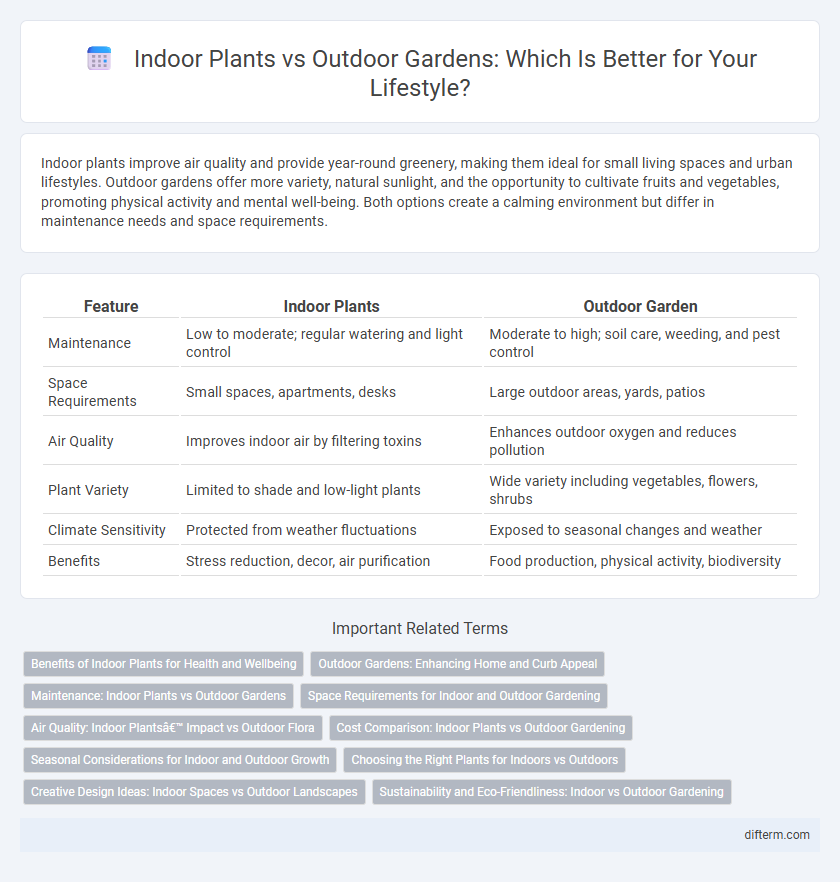Indoor plants improve air quality and provide year-round greenery, making them ideal for small living spaces and urban lifestyles. Outdoor gardens offer more variety, natural sunlight, and the opportunity to cultivate fruits and vegetables, promoting physical activity and mental well-being. Both options create a calming environment but differ in maintenance needs and space requirements.
Table of Comparison
| Feature | Indoor Plants | Outdoor Garden |
|---|---|---|
| Maintenance | Low to moderate; regular watering and light control | Moderate to high; soil care, weeding, and pest control |
| Space Requirements | Small spaces, apartments, desks | Large outdoor areas, yards, patios |
| Air Quality | Improves indoor air by filtering toxins | Enhances outdoor oxygen and reduces pollution |
| Plant Variety | Limited to shade and low-light plants | Wide variety including vegetables, flowers, shrubs |
| Climate Sensitivity | Protected from weather fluctuations | Exposed to seasonal changes and weather |
| Benefits | Stress reduction, decor, air purification | Food production, physical activity, biodiversity |
Benefits of Indoor Plants for Health and Wellbeing
Indoor plants significantly improve air quality by absorbing toxins and increasing oxygen levels, which enhances respiratory health and overall wellbeing. Their presence reduces stress and anxiety through biophilic effects, promoting mental clarity and emotional balance. Regular interaction with indoor greenery boosts mood, productivity, and sleep quality, making them essential components of a healthy lifestyle.
Outdoor Gardens: Enhancing Home and Curb Appeal
Outdoor gardens significantly enhance home curb appeal by incorporating a variety of plants, flowers, and landscaping elements that create a vibrant and welcoming environment. Strategic placement of shrubs, decorative trees, and colorful blooms adds texture and depth, increasing property value and aesthetic charm. Well-maintained outdoor gardens also promote biodiversity, attracting pollinators and improving the ecological balance around residential spaces.
Maintenance: Indoor Plants vs Outdoor Gardens
Indoor plants require consistent watering, controlled humidity, and occasional pruning to thrive in limited spaces, making maintenance more predictable but often time-sensitive. Outdoor gardens demand more variable care, such as seasonal soil preparation, pest control, and adapting to weather fluctuations, which can increase both time and effort. The choice between indoor plants and outdoor gardens hinges on individual lifestyle and maintenance preferences, balancing convenience with environmental interaction.
Space Requirements for Indoor and Outdoor Gardening
Indoor gardening demands minimal space with options like small pots and vertical planters suitable for apartments and limited areas, optimizing compact living environments. Outdoor gardening requires ample land, ideal for larger flower beds, vegetable patches, and trees that need open sunlight and natural airflow. Tailoring space usage based on available square footage enhances plant growth and overall gardening success in both settings.
Air Quality: Indoor Plants’ Impact vs Outdoor Flora
Indoor plants significantly improve air quality by filtering pollutants such as formaldehyde, benzene, and trichloroethylene through natural processes like photosynthesis and transpiration. Outdoor gardens contribute to air purification on a larger scale by producing oxygen and absorbing carbon dioxide, while also reducing ambient air temperature and particulate matter. Both environments play crucial roles in enhancing overall air quality, but indoor plants provide targeted benefits within confined living spaces.
Cost Comparison: Indoor Plants vs Outdoor Gardening
Indoor plants typically require lower initial investment and maintenance costs compared to outdoor gardening, as they need less soil, fertilizers, and pest control measures. Outdoor gardens involve expenses for landscaping, irrigation systems, and seasonal plant replacement, which can increase overall costs significantly. Evaluating budget constraints and space availability helps determine the most cost-effective option between indoor and outdoor plant care.
Seasonal Considerations for Indoor and Outdoor Growth
Seasonal considerations significantly impact the growth of indoor plants and outdoor gardens, with outdoor plants thriving during specific warm months while indoor plants benefit from controlled environments year-round. Outdoor gardens require attention to frost dates, sunlight duration, and soil temperature fluctuations, which can limit planting times and species selection. Indoor plants, on the other hand, rely on consistent humidity, artificial lighting, and temperature regulation, allowing for continuous growth regardless of external seasonal changes.
Choosing the Right Plants for Indoors vs Outdoors
Selecting the right plants for indoor spaces requires focusing on species that thrive in limited sunlight and controlled temperatures, such as snake plants and pothos. Outdoor gardens benefit from native plants and those suited to the local climate, including perennials like lavender and ornamental grasses, which enhance sustainability and growth success. Understanding the distinct light, water, and soil needs of indoor versus outdoor plants ensures healthier growth and a vibrant living environment.
Creative Design Ideas: Indoor Spaces vs Outdoor Landscapes
Creative design ideas for indoor plants emphasize compact arrangements, vertical gardens, and stylish pots to maximize limited space and enhance modern interiors. Outdoor landscapes offer expansive opportunities for integrating native plants, garden sculptures, water features, and natural pathways that transform yards into dynamic, immersive environments. Combining elements like hanging planters indoors with outdoor living rooms creates a seamless transition between indoor elegance and outdoor natural beauty.
Sustainability and Eco-Friendliness: Indoor vs Outdoor Gardening
Indoor plants enhance air quality by filtering toxins and require less water, reducing environmental impact compared to large-scale outdoor gardens. Outdoor gardening supports biodiversity and natural ecosystems by providing habitats for pollinators and wildlife, promoting sustainable land use. Choosing between indoor or outdoor gardening depends on space, climate, and personal sustainability goals, with both methods offering unique eco-friendly benefits.
indoor plants vs outdoor garden Infographic

 difterm.com
difterm.com